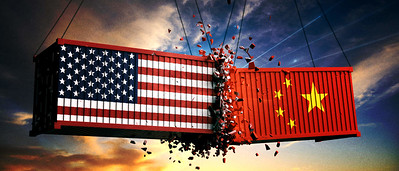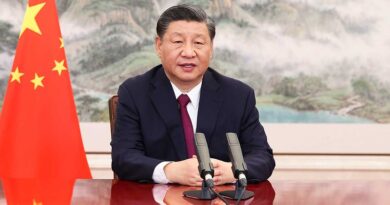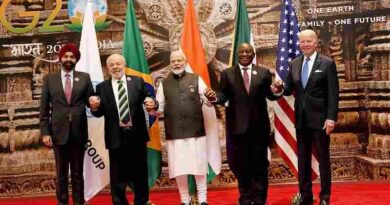Trade Diplomacy in the Age of Conflict: US-China Trade Relations
Introduction
One of the most significant and complicated dynamics in the world economy is the trade relationship between the United States and China. As both nations are economic powerhouses, any changes or disagreements in their trade ties have far-reaching effects that resonate across industries and marketplaces globally. The focus of debates on the state of the world economy has long been on US-China trade ties. The relationships between the two biggest economies in the world have a significant impact on investment, trade, and economic stability.
Historical Context:
The early 1970s, when diplomatic contacts were restored between the two countries, laid the groundwork for the current US-China trading partnership. The US-China trade relationship gradually grew when China began its economic reforms and liberalization initiatives in the late 1970s. A significant turning point was reached with China’s WTO membership in 2001, which sparked a bilateral trade and investment boom.
Recent Developments in US-China Trade Relations:
- On 25th of May,2023, Gina Raimondo, Secretary of Commerce of the United States, met with her Chinese counterpart Wang Wentao in Washington, D.C., to discuss bilateral trade challenges. This was the first cabinet-level exchange between the two countries in months. The discussions centered on American companies working in China and addressed concerns concerning both countries’ general trade and investment environment. Raimondo raised concern regarding recent actions by the People’s Republic of China (PRC) against American corporations operating in China. As relations between the world’s two largest economies deteriorate, players in the market are keeping an eye to see if the United States will restrict American investment in China.
- The 49th G7 leaders’ summit was held in Hiroshima, Japan from 19th – 21st May 2023 where the leaders of the G7 countries pledged to implement a strategy of “de-risking” from China during their summit in Hiroshima, voicing concerns about some practices that they fear can harm the world economy. The declaration emphasizes G7 nations’ rising concern about China’s unfair trade practices and their potential ramifications for the worldwide economic environment.
Trade Disputes and Structural Issues:
Despite being beneficial for both countries, several structural problems in the US-China trade relationship continue to raise concerns. Intellectual property theft, forced technological transfers, impediments to market access, and the trade imbalance developed into hot-button issues. Negotiations and reforms were required to address these issues after the US accused China of unfair trade practices and abuses of intellectual property.
Escalation of Trade Tensions:
Trade tensions between the US and China increased dramatically under the Trump administration. Due to unfair trade practices and worries about national security, the US slapped tariffs on Chinese goods in 2018. China responded by placing duties on US goods, sparking a full-fledged trade war. This trade war between the US and China has affected several businesses on both sides, caused uncertainty, and shaken up global supply lines. In industries like agriculture, technology, manufacturing, and consumer products, the trade war had a significant impact.
Phase One Trade Agreement:
On January 15, 2020, the United States and China signed the Phase One Trade Agreement, which was a significant development in their ongoing trade conflict. The deal attempted to assuage some of the main worries and lay the groundwork for future conversations. The Phase One Trade Agreement’s primary features and aspects are listed below:
- China has agreed to buy more US agricultural products, such as soybeans, pigs, chicken, and other items, in the future. The objective was to support American farmers by reducing the agricultural trade imbalance.
- Protection of Intellectual Property: The agreement had clauses that addressed forced technology transfer, counterfeit prevention, and intellectual property protection. It aimed to improve intellectual property law enforcement and level the playing field for US businesses doing business in China.
- Financial Services and Market Access: China pledged to open up its market to more US financial companies and remove obstacles in the banking, insurance, and asset management sectors. The deal aims to make it easier for US businesses to operate in a more liberalized and vibrant financial market in China.
- Currency Manipulation: The agreement detailed pledges to prevent competitive currency devaluations and refrain from manipulating exchange rates to gain trade benefits. It aimed to advance equitable monetary practices and improve the transparency of monetary policies.
- Dispute Resolution: The agreement established a dispute resolution process to handle disagreements and guarantee adherence to the agreed-upon terms. In a timely manner, both nations agreed to settle differences through negotiations and consultations.
It is crucial to keep in mind that the Phase One Trade Agreement did not cover all of the intricate issues between the US and China and was only meant to be a partial resolution to the trade dispute. The agreement reduced tensions to some extent and stopped them from rising, but there were still important issues and unresolved structural problems.
The COVID-19 pandemic’s emergence, which hindered international trade and economic activity, was a major hurdle to the Phase One Trade Agreement’s implementation. The pandemic’s effects on both nations’ economies made the trade connection even more complicated.
Geopolitical Factors and Technological Competition:
Economic ties between the US and China have been impacted by factors other than conventional economic issues, such as geopolitics and technological competition. China’s rapid advancement is seen as a potential threat to the US’s dominance of the world by China. 5G technology, artificial intelligence, cybersecurity, and supply chain security are just a few of the fields where strategic competition exists. Regarding how Chinese businesses are developing vital infrastructure and technologies, the US has expressed worries about national security.
Impact on Global Economy:
- Global supply networks that are closely entwined with China’s manufacturing industry have been affected as a result of trade tensions. Tariffs and trade restrictions have had a negative impact on enterprises worldwide, including higher costs, lower efficiency, and uncertainties. Manufacturers now need to reassess their supply chain strategy, bringing diversification and relocation alternatives into consideration.
- Trade conflicts have slowed down global economic development. Multiple nations and areas have experienced a decline in investment and consumption due to increased uncertainty and diminished corporate confidence. Global markets are impacted when the two largest economies in the world, the US and China, do less well economically.
- Market Volatility: The fluctuations in trade negotiations and policy announcements have caused volatility in financial markets. Stock markets have reacted to trade-related news, impacting investor sentiment and increasing market uncertainty. The ripple effects of market volatility can affect consumer confidence, business decisions, and investment patterns globally.
- Commodities and Agricultural Sectors: The trade disputes have impacted commodity markets and agricultural sectors. Tariffs and retaliatory measures have affected the prices and demand for commodities such as soybeans, pork, and other agricultural products. Farmers and producers in various countries have faced challenges due to changing trade dynamics.
- Investor Confidence: The trade tensions have raised doubts and sapped investor enthusiasm. Due to the uncertainty surrounding trade policies, businesses that were considering investments or expansions have become hesitant. As businesses re-evaluate the risks connected with cross-border projects, foreign direct investment flows could be impacted.
- Concerns regarding the viability of the rules-based global trading system have been voiced as a result of the trade disputes. The use of tariffs as a tool to address trade concerns has departed from accepted trade principles and heightened tendencies towards protectionism. Countries that depend on open trade now face uncertainty and difficulties as a result.
Changing Dynamics Under Biden Administration:
- Multilateral Engagement: In engaging with China, the Biden administration has adopted a more multilateral strategy. In order to address common concerns about China’s trade practices, violations of intellectual property rights and human rights, it has worked to develop ties and alliances with like-minded nations. This strategy seeks to create a larger coalition in order to exert pressure and influence on China as a whole.
- Review of Trade Policy: The Biden administration thoroughly examined US trade policy, notably the country’s trading relations with China. This analysis sought to evaluate the efficacy of prior strategies, pinpoint areas for development, and create a comprehensive plan for handling China’s economic issues.
- Human Rights Issues: In its approach to China, the Biden administration paid greater consideration to human rights issues. It has been forthright about worries about how China treats Uighur Muslims in Xinjiang, the loss of freedom in Hong Kong, and violations of human rights in Tibet. This emphasis on human rights has shaped the two nations’ economic and trade relations.
- Technology and supply chain security has been accorded top priority by the Biden administration in their dealings with China. It has voiced alarm over China’s hegemony in key fields like cybersecurity, artificial intelligence, and 5G. Aiming to reduce potential national security vulnerabilities brought on by Chinese corporations, efforts have been made to enhance local supply chains, advance technical innovation, and take steps to solve these issues.
- Tariff Review: The Biden administration has examined the tariffs levied during the trade conflict with China. There have been changes, including exclusions and exemptions for specific products, even if some tariffs are still in effect. Evaluation of the effects of tariffs on US firms and consumers has been a key focus, along with the search for a fair strategy that advances economic interests while resolving trade issues.
- Engagement and Dialogue: The Biden administration has remained committed to engagement and dialogue with China despite changes in strategy. High-level conferences and discussions have been held to address issues of shared concern, like public health and climate change. To resolve disagreements and identify areas of cooperation, the administration has emphasized the value of open channels of communication.
- The Biden administration has placed a strong emphasis on the necessity to boost US economic competitiveness so as to compete with China. It involves making investments in R&D, technological innovation, education, and workforce development to make sure that the United States maintains its position at the fore of global economic leadership.
It is significant to emphasize that, regardless of strategy modifications, several fundamental problems with the US-China trade relationship continue to exist. The dynamics between the two countries are still shaped by structural issues, restrictions on market access, concerns about intellectual property protection, and geopolitical conflicts.
The complex and multifaceted nature of the relationship will likely continue to be reflected in the changing dynamics of US-China trade ties under the Biden administration. Future US-China trade relations will be shaped by constant communication, strategic engagement, and a balance between rivalry and collaboration.
Future Prospects of US-China Trade Relations:
The outlook for the future of US-China trade relations is linked with various opportunities and challenges. Here are some crucial variables to consider:
Economic Interdependence:
The US and Chinese economies stay primarily intertwined. Both countries have an interest in keeping trade ties stable in order to foster economic growth, job creation, and the welfare of consumers. Their economies’ sheer size and significance suggest that future engagement will be critical for global economic stability
Geopolitical conflicts:
Trade relations are still shaped by geopolitical conflicts between the United States and China. Divergent strategic objectives, national security concerns, and struggle for influence can all hinder efforts to create a mutually advantageous trading framework. The challenge of balancing economic cooperation with geopolitical realities is continuous..
Structural barriers:
such as protection of intellectual property, access to markets hurdles, and subsidies from the government, continue to be key challenges in the trading relationship. To address these concerns, substantial agreements and reforms are required in order to provide a level playing field for enterprises from both countries.
Technological Rivalry:
The United States and China are competing for technical domination. Competition in sectors such as 5G, AI, cybersecurity, and sophisticated manufacturing has far-reaching consequences. In these industries, striking a balance between collaboration and competition will be critical for future trade relations.
Global Supply Chain:
The COVID-19 pandemic exposed flaws in global supply chains, forcing an examination of their structure and resilience. The US-China trade relationship must adjust to new supply chain dynamics, such as diversification, localization, and effective risk mitigation practices.
Environmental Concerns:
Climate change and sustainable development have emerged as significant worldwide challenges. As the world’s greatest emitters of greenhouse gases, the United States and China have a vital role to play in tackling these issues. Cooperation in renewable energy technology, carbon pricing, and environmental legislation will have an impact on future trade ties.
The ability of both nations to manage problems, establish common ground, and promote fair, balanced, and mutually beneficial trade will determine the future of US-China trade relations. Forging a road forward that supports economic growth, stability, and shared prosperity will need ongoing conversation, transparency, and a commitment to resolve disagreements via talks.



